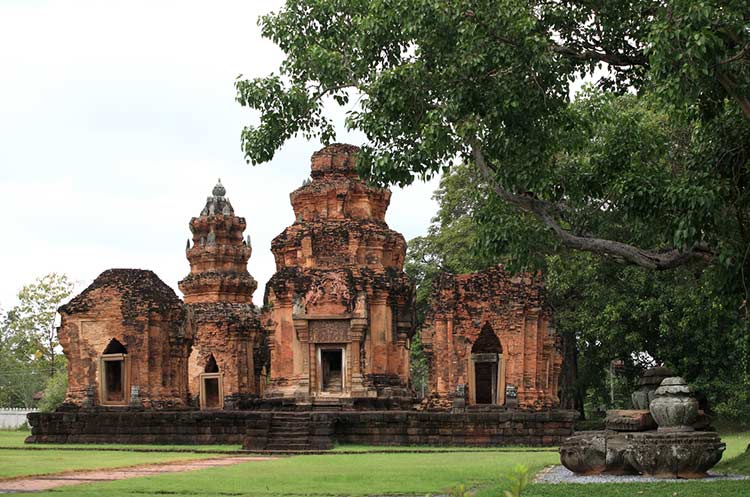
Surin
Elephant round-up & ancient Khmer temples
Surin is a little visited province in the lower part of Northeast Thailand, the area known as Isan. The province bordering Cambodia with capital Surin town is known for its annual elephant round-up, ancient Khmer temples and handicraft villages.
Under control of the Khmer
For several centuries Surin was under control of the Khmer empire from Angkor. A great number of Khmer temples were build, of which many remain today in various states of preservation. The provincial seal depicts the Hindu God Indra riding the three headed elephant Airavata, a scene often depicted on Khmer temples.
To do & see in Surin
Surin province houses a number of historical and cultural attractions that are worth a visit.
Elephant round-up
Surin province is best known for its elephant round-up, an annual event that takes place in November. In the history of Thailand elephants have played an important role in wars and later in the logging business. The event features a parade of elephants, various shows and performances to demonstrate the skill and strength of the animals as well as dance and music shows. Highlight of the round-up is the re enactment of several historic battles with elephants carrying soldiers dressed in traditional battle uniforms armed with ancient weapons. The event is held at Si Narong stadium in Surin town.
Khmer monuments
Spread across the province are the remains of a large number of Khmer temples that were constructed when the area was under control of the Khmer empire. Surin’s best known Khmer monument is Prasat Sikhoraphum, a Hindu temple dedicated to Shiva, constructed in the 11th or 12th century. The sanctuary features five large prangs standing on a laterite platform. Several lintels and pilasters contain well preserved bas reliefs. The temple is located in Sikhoraphum village, about 40 kilometers East of Surin town.
Handicraft villages
Around Surin province are many villages where various handicrafts are produced. Villagers have been making silk, rattan, silver and gold ware items for centuries to provide supplementary income after the rice had been harvested.
The village of Ban Buthom is known for its hand woven products made from rattan like baskets and trays. The villagers of Ban Chok village in Khwao Sinarin district have been producing silverware ornaments for centuries. Ornaments in various shapes and designs are made like necklaces, bracelets, belts and rings. Several silk weaving villages, the best known of which is Ban Khwao Sinarin produce high quality silk handwoven into various patterns. Visitors can observe how the handicrafts are produced and buy items in one of the many shops.
Getting to Surin
Surin is located 440 kilometers Northeast of Bangkok and can be reached by train and bus.
Air
Surin Pakdi Royal airport is located just South of Surin town. Currently there are no scheduled flights from Bangkok.
Train
Surin is on the State Railway of Thailand’s Northeastern line. Multiple times daily trains depart from Bangkok Hua Lamphong station, including sleeper trains. The 420 kilometer trip takes 6½ to 8½ hours depending on the type of service. Fares are 73, 169 and 346 Thai Baht for third, second and first class.
Check details and how to get tickets at Travel Thailand by train.
Bus
Ordinary and air con buses to Surin leave from Bangkok’s Northeastern bus terminal Mo Chit II on Kamphaeng Phet 2 road. The trip takes about 8 hours. Fares vary between 450 and 550 Thai Baht depending on the type of service.
The Surin bus station is located on Jitrbumrung road (Highway 214), a few hundred meters South of the train station.
Buy tickets online
Tickets for bus, train or taxi from Bangkok or another city can be bought online at the 12Go website.